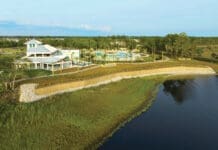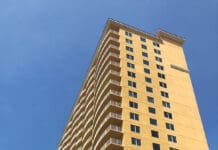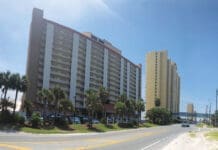By Ed Offley
The orange traffic signs are up everywhere on the Panama City Beach “island.”
Don’t expect their removal anytime soon.
From Clara Avenue to the Lake Powell Bridge in unincorporated Bay County, the Panama City Beach Parkway (US 98) this month has turned into a ten-mile construction zone as the Florida Department of Transportation (FDOT) launches a multi-year widening of the roadway from four to six lanes in addition to interim road improvements west of SR 79.
Meanwhile, the Panama City Beach Community Redevelopment Agency (CRA) has begun work to elevate and improve Alf Coleman Road between the parkway and Hutchinson Boulevard which will result in the closure of the street to through traffic for the next ten months.
For both FDOT and the CRA, this is only the tip of the iceberg.
City and state highway officials are beginning what promises to be at least a decade of disruption and traffic congestion throughout the “island” as they carry out a multi-million-dollar series of projects aimed at curing the area’s worsening gridlock. Designed for a capacity of 45,000 vehicles each day, the four-lane parkway linking Walton County and Panama City regularly experiences daily peak traffic exceeding 80,000 vehicles.
“We needed this project five or more years ago,” Mayor Mark Sheldon told PCB Life earlier this year. “Panama City Beach Parkway is over its capacity, and it has been for some time. Two additional lanes are desperately needed to enable traffic to keep flowing.”
The initial phase of the parkway widening began in earnest in late September. It is a $50-million, 2.34-mile segment running from the entrance to Frank Brown Park at Mandy Lane to Nautilus Street. Roadside barriers and construction zone signs went up the week of September 11.
In addition to adding the extra traffic lane on either side, the project includes a seven-foot-wide bike lane and a six-foot concrete sidewalk on both sides of the roadway. Where deemed necessary, sound-buffering walls are also in the plans. The project will remain within the existing right-of-way by narrowing the existing median strip, according to FDOT spokesman Ian Satter.
Also slated to begin construction this month is a second segment that will run 2.3 miles from Nautilus Street to Richard Jackson Boulevard. It is currently budgeted at $60 million.
Both segments are scheduled for completion in late 2027.
The final phase – a 3.9-mile stretch of the parkway from Richard Jackson Boulevard to the foot of the Hathaway Bridge is estimated at $61 million, has not been funded but remains in the highway department’s long-term plan. That segment’s completion date, while tentative, will be at least five years away.
Meanwhile, FDOT in May announced its “preferred alternative” for six-laning the western stretch of the parkway from the Bay-Walton County line to SR 79, including replacing the Lake Powell bridge. No firm cost estimate or construction schedule has yet been made, and it is unlikely to begin before the earlier segments are finished.
Motorists trying to avoid construction on US 98 will not find much relief on Front Beach Road over the long term.
In Panama City Beach, City Council last month greenlighted an accelerated plan to convert Front Beach Road from a two-lane roadway into a divided roadway with bicycle lanes, sidewalk, underground utilities and landscaping. City Council on September 14 approved a $56.3 million CRA budget for the 2023-24 fiscal year, with nearly $28 million assigned to Front Beach Road. Another $4.7 million is assigned to the interim Alf Coleman Road improvements.
CRA Segment 3, including SR 79 from the parkway to Front Beach Road, a traffic roundabout, and Front Beach Road east to Sterling Reef condominiums, has been under construction for several years and is a continuing project. Work will continue during 2023-24 with an $8.9 million appropriation, said CRA administrator Scott Passmore.
The widening and reconstruction of SR 79 from US 98 to the Front Beach Road roundabout should be finished by the end of the year, with the rest of Segment 3 completed by the end of 2024, almost a year later than originally planned.
The CRA – like other developers – has had to work through a number of problems including inflationary increases in materials costs, chronic worker shortages, and the sheer complexity of dealing with private landowners and utility companies, Passmore said.
One additional complication is the Front Beach Road right-of-way itself.
“We’re putting a five-lane roadway inside a 66-foot-wide corridor,” Passmore said. “That’s incredibly tight. It’s a challenge but we’re working around that.”
Design and planning work for Segment 4.1 (Front Beach Road from Sterling Reef to Hills Road) and Segment 4.2 (Hills Road to the intersection with Hutchinson Boulevard) are nearly complete and construction is expected to begin on both near the end of 2024, Passmore said. Construction work will take at least three years to carry out.
Segment 4.3, running on Front Beach Road from Hutchinson Boulevard to Richard Jackson Boulevard, is still undergoing land acquisition and design, Passmore said. Barring delays, that CRA segment will begin construction in early 2025 and will also take about three years to finish.
Other CRA projects on the drawing board for future funding include the completion of four-laning Powell Adams Road, Hills Road, and Clara Avenue, he said.





















































